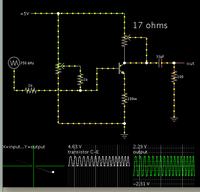boylesg
Advanced Member level 4

- Joined
- Jul 15, 2012
- Messages
- 1,023
- Helped
- 5
- Reputation
- 10
- Reaction score
- 6
- Trophy points
- 1,318
- Location
- Epping, Victoria, Australia
- Activity points
- 11,697
I have been reading about impedance matching between amplifier stages and that ideally you need the input impedance of stage n+1 to be much greater than the output impedance of stage n.
So it is an easy matter to work out the input and output impedances of a class A amplifier - TransistorAmp software does it for you.
But how do you work out the input and output imdendance of a complementary pair? I can find no websites that tell you how to do this. Is the input imedance simply the BE impedance of the transitors in the pair? And if so where do you get that sort of info from because the datasheet for BC327 for example does not specify these parameters.
So it is an easy matter to work out the input and output impedances of a class A amplifier - TransistorAmp software does it for you.
But how do you work out the input and output imdendance of a complementary pair? I can find no websites that tell you how to do this. Is the input imedance simply the BE impedance of the transitors in the pair? And if so where do you get that sort of info from because the datasheet for BC327 for example does not specify these parameters.

